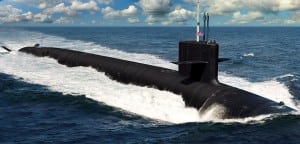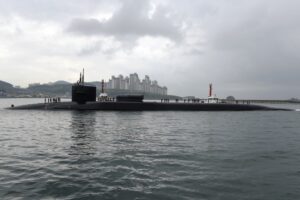The top Navy officer for procuring and sustaining ballistic missile submarines (SSBNs) this week noted there are risks in extending the life of some of the current Ohio-class SSBNs to add margin to the new Columbia-class SSBNs, but lessons from converted guided-missile submarines (SSGNs) will help
“Right now we have not operated submarines out to 42 years. We’ve come close with some fast attack submarines that we’ve had out in the 40-year range but it’s kind of unchartered territory so there are certainly risks with that, so we’re watching that very closely,” Rear Adm. Scott Pappano, Program Executive Officer for Strategic Submarines, said during an Air Force Association Mitchell Institute event on Aug. 24.

In May, Pappano confirmed the Navy is evaluating short term service life extensions “for a couple of years” of up to five Ohio-class SSBNs (Defense Daily, May 16).
The 14 Ohio-class submarines were originally designed to serve for 30 years, but in the 2000s they were studied and extended to have 42-year service lives. The first of the 14 Ohio-class boats is expected to reach the end of that life in 2027, with the others ending service at a rate of one per year until 2040. The Navy is planning to buy at least 12 Columbia-class submarines to replace them for the SSBN mission.
In May, Pappano said if the Navy indeed does extend the life of some Ohios the first one would start in fiscal year 2029.
Pappano this week said that given the heel to toe construction on Columbia-class submarines, “I think that to meet my requirements to [U.S. Strategic Command], which is having 10 submarines ready for sea….there are going to be times when I intend to make 10 in the 2030s and I think it would be a great idea to have a couple other hulls around both to buy down risk for the unknown unknowns and support additional D-5 LE2 missile testing. So we are looking right now, in effect planning to do individual service life extensions.”
He said the Navy is planning to do individual service life extension on up to five SSBNs through pre-inactivation restricted availabilities, “where we spend about 18 months in the depot to buy about three years on the back end and extend some of those Ohio-class submarines to have a couple around as we bring on the Columbia-class to make sure we have them.”
Pappano said one of the ways the service is mitigating risk on extending Ohios is learning from its experience operating the four oldest Ohio-class submarines, previously converted into non-nuclear armed guided-missile submarines (SSGNs).
“And we we have run those ships very, very hard. Much harder operating profile, much harder operating environment than the SSBN platform by where they go, what they do. The term I’ve used is a canary in the coal mine for us for things to look for. So we’re calling data back, we’re looking at the SSGNs right now and learning from them to get to the Ohio standard class.”
He argued he does not worry about the hulls of the Ohio-class for life extensions, but their other systems.
“We’ll figure out the hull, it’s just metal, I can weld metal. It’s in the Aegis, you know what systems have degraded over time, whether it’s, think about a plumbing system – that sea connected system, and what’s the erosion/corrosion on that and how much of that piping system are we cutting out as we do these material condition assessments on these ships to get them to end of life.”
Pappano said that when the Navy starts to take the SSGNs offline, before the SSBNs are decommissioned, “we’ll start doing some destructive analysis of those ships to make sure we fully inform our ability to sustain the Ohio’s to the end of life.”

Pappano added his office is also doing all it can to push the Columbia-class earlier, including “earlier long-lead time procurement, earlier advance construction and those kind of things to try to continue to bring the class back to the left, to minimize any gaps, eliminate any gaps and gives us as much overlap as we can.”
He said the first Columbia-class submarine, the future USS District of Columbia (SSBN-826), is about 25 percent complete.
Shipbuilder General Dynamics Electric Boat [GD] held a keel laying ceremony for SSBN-826 in June and at the time the company said the vessel was over 20 percent complete (Defense Daily, June 6).
Pappano said the Navy’s procurement plan for the next SSBNs is to get the next five vessels on the next contract, with the third vessel starting in fiscal year 2026.
“I’d love to do all 10. But you know, that’s just kind of a bridge too far right now. But we’ll look at material buys for those because the other thing I want to do is, as far as risks in the industrial base, as much as I can level load them and get a demand signal to the industrial base.”